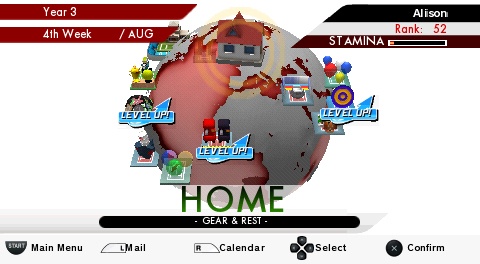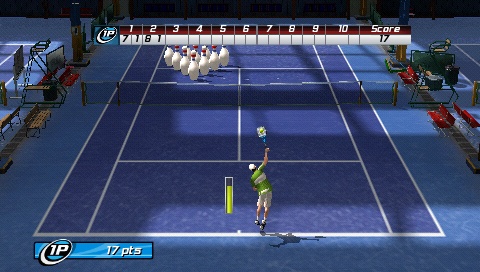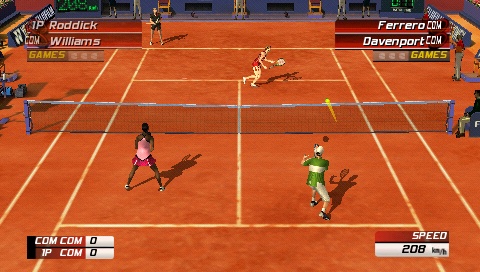Sega's tennis series has had a multitude of names over the years: Virtua Tennis, Power Smash, and Sega Sports Tennis. While the names may differ depending on location and year, the games have always been easy to pick up and play and hard to put down. Virtua Tennis 3 is a great game that holds true to that winning formula. There are some new minigames, and the career mode has been fleshed out, but it's clear that the developers were focused on refining the gameplay rather than reinventing it.

Virtua Tennis' biggest lure is its career mode, which is deeper than the previous game but still pretty basic when compared to most other sports games. You start by creating a male or female player using the game's limited character editor. After you select a spot on the globe for your home, it's time to start on your 20-year quest to go from the 300th-ranked player to the top-ranked player in the world. But you can't just rush out and take the top spot; you'll need to start by training your player. This can be done by going to tennis school or by playing minigames. Going to tennis school is a great way to learn the basics while at the same time leveling up your player. Here you're given a task, such as to hit a maximum-power forehand or finish a point with a smash. If you can do the task three times in the given time limit, the skills that you used in the test will be increased.
Tennis school is fun, but not as much fun as the minigames, which, as always, are fantastic. Each minigame focuses on one of four aspects of your game: ground stroke, serve, volley, and footwork. A few games return, but most are slight variations or altogether new. Avalanche has you collect fruit and dodge large tennis balls that roll out of the back of a dump truck. In Drum Topple, you try to knock over stacked oil drums by hitting ground strokes. Prize Defender places you in front of a table filled with prizes, and you must protect the items by volleying away shots from the ball machines. In Pin Crusher, you try to knock down bowling pins with your serve. Each of the minigames starts easy, but as you get better, the games get more difficult. They're pretty punishing on the highest levels, but you can always choose a lower difficulty setting. This yields fewer points, but it keeps the game from being frustrating. If you really love the minigames, you can play them outside of the career mode, but for some reason, you can't play them via ad hoc. However, you can use the ad hoc connection to play exhibition matches against someone else with a copy of the game. This works fine, but it would be nice if the game offered a few more options or even Internet play.
Once you've got the basics down, it's time to start chipping away at that number-one ranking. You do this by entering the singles and doubles tournaments that are open to newcomers. Tournaments take place in locations such as Spain, China, France, England, USA, Australia, Germany, Italy, and more. You'll play day and night, as well as indoors and out on clay, grass, and hard courts. To win the early matches, you've got to take just two short games, but the matches get longer as the tournaments get more prestigious. One quirk from previous games that holds true here is that rather than complementing the roster of real players with fictitious players, you'll be playing the same handful of real-life players over and over again. You might play and beat the tar out of Roger Federer your first match, which kind of takes the mystique out of facing one of the greatest players of all time.
Your stamina decreases as you train and play tournaments. If there's a tournament you don't want to miss, you can replenish your stamina with an energy drink and not lose any time, but this increases your risk of injury. To avoid injury, it's important to occasionally take a week off at home, or even go on a three-week vacation every now and then. Injuries are most prevalent when your stamina is low, but they can strike at any time. Unfortunately, there isn't much to injuries. They occur while you're in the main menu--you don't get hurt during matches. The game tells you that you're hurt and for how long and then simply skips ahead. You get e-mail from your coach, who will give you tips, read you fan mail, and award you items. Other players will periodically ask you to practice with them or, in a really awkward cutscene, encourage you or talk smack. There's also no money system, and you're awarded items based on your play. This feels like a step back because there isn't much in the way of items, and it was always fun to spend, like, a thousand dollars on some wrist bands.

Tennis school, minigames, and e-mail--it's all secondary to the action on the court, which is excellent in Virtua Tennis 3. The game is fast-paced and arcadelike. It's a breeze to play, thanks to controls that are simple yet allow for a wide variety of shots. There are just three shot buttons, but depending on your location on the court, you can hit a top-spin shot, a slice, a drop shot, a volley, a slam, or a lob with ease. The earlier you get into position to hit the ball and press the shot button, the harder your shot will be. Serving is as simple as tapping a button to start the serve and then tapping it again when you've reached the desired level of power. You can aim your serve and your shots by pressing the analog stick or D pad as you hit the ball. Using the analog stick to control your player generally works well, but it often isn't precise, and you'll occasionally lose points because of it. Players move quickly and will automatically dive for balls out of their reach, and they rarely hit the ball out of bounds or into the net. Even though the controls are simple, there are many different ways to play. How you play the game is dependent on not only your skill, but also your opponent's skill and the type of court you're playing on. You'll see some players stick to the baseline and trade forehand blasts, while other players will employ the serve-and-volley technique. The early matches are typically pretty quick, but as you get further into the game, the points grow longer. Even then, though, there's plenty of action.
This may be the most refined version of Virtua Tennis yet, but there are still some minor issues that keep the gameplay from being truly superb. There's often a quick hitch before players hit a shot, which makes it tough to judge the angle of the ball coming off the racket. Lobs are almost completely ineffective against CPU-controlled players, who get to nearly any ball lobbed over their head and will slam it right back with ease. This makes anyone who uses serve-and-volley tactics extremely difficult to beat. Volleying is inconsistent, too. Sometimes you can volley with authority, but other times you'll be standing at the net ready to put away a ball that's right at your racket, but your player will hit a soft shot that gives your opponent plenty of time to recover. It can also be difficult to position your player properly before a shot. Sometimes you'll hit the ball when it's too low to the ground, and other times you'll be just a hair too far away and hit a weak running shot or, worse, dive for a ball you could have easily gotten to. But these are exceptions to what is, for the most part, outstanding gameplay.
Virtua Tennis 3 is a good-looking game, but it doesn't look much better than its predecessor. In fact, the frame rate has gotten worse and often struggles to keep up with the action. Player models are detailed and, despite a few exceptions (like a rough-on-the-eyes Maria Sharapova), look like their real-life counterparts. There's some noticeable tearing during cutscenes, and it's also easy to notice seams between textures. Players move realistically as well, and they have different-looking strokes. You'll even notice little things like players sliding a bit when they try to change directions too quickly. Overall, the courts look nice, and there are some nice details, such as how the ball leaves a mark on clay courts. Just don't look too closely into the stands at the animated blobs that are supposed to be fans. One thing that's a bit disappointing is that there's still no user-controlled instant replay; you're at the mercy of the game (and some lousy camera angles) if you want to relive a great shot. The instruction manual indicates that you can use the select button to bring the camera down and behind the player as in the previous game, but pressing select doesn't do anything.

If you've ever played a Virtua Tennis game before, you've got a pretty good idea of how this iteration sounds. Cheesy guitar rock plays during the menus and matches; some people will love it, others will loathe it. Sound effects are spot-on, though some of the player grunting and yelling is a bit obnoxious. The crowds react appropriately to what's happening on the court, and there are PA announcers that give the score in their countries' native tongue, which is a nice touch.
If you never played the previous Virtua Tennis, this is the version to get thanks to the tweaks and additions that have made career mode more enjoyable. However, Virtua Tennis 3 doesn't feel vastly different from its predecessor, and there's still no online play, so you might want to take a pass if you played the previous game.